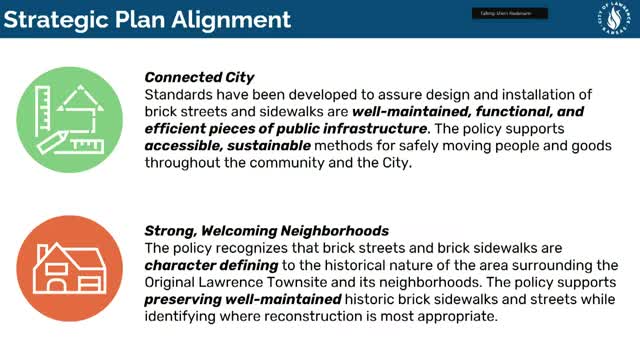City adopts new policy to preserve historic brick streets
September 17, 2024 | Lawrence, Douglas County, Kansas
This article was created by AI summarizing key points discussed. AI makes mistakes, so for full details and context, please refer to the video of the full meeting. Please report any errors so we can fix them. Report an error »

In a recent government meeting, officials unveiled a comprehensive policy aimed at the preservation and maintenance of brick streets and sidewalks in Lawrence, emphasizing the balance between historical integrity and modern accessibility. The policy is designed to ensure that these vital pieces of public infrastructure are not only functional but also reflect the community's rich heritage.
Key highlights of the policy include the establishment of standards for the design and installation of brick sidewalks and streets, which are deemed essential to the character of the original Lawrence Town site and its neighborhoods. The initiative prioritizes safety, accessibility, and sustainability, addressing the community's desire for well-maintained historic brick infrastructure while accommodating the need for new, accessible pathways.
A citywide survey conducted at the outset of the policy development process revealed that safety, accessibility, and sustainability were the top priorities for both brick sidewalks and streets. In response, the policy includes detailed installation and maintenance standards, ensuring that brick sidewalks meet federal accessibility guidelines (PROWAG standards) and that historic bricks are reused in street designs.
The policy also introduces a \"brick sidewalk permissive map,\" which identifies areas where property owners can choose to construct sidewalks in either brick or concrete, a shift from previous regulations that mandated concrete for existing sidewalks. This map was revised based on public feedback to include additional historic districts, allowing for greater community involvement in the decision-making process.
For brick streets, many of which date back over a century, the policy outlines preservation strategies, categorizing streets into primary and secondary preservation statuses. Streets designated for primary preservation will remain exposed brick, while those with secondary status may be maintained with standard materials. The policy also establishes a formal process for residents to express interest in restoring covered brick streets, streamlining what has previously been an informal and uncertain request process.
The implementation of this policy will align with the city's ADA transition plan, which aims to repair and reconstruct non-accessible sidewalks over the next two decades, ensuring that all community members can navigate the city safely and comfortably.
As the policy moves forward for approval, it has already received endorsements from both the Historic Resources Commission and the Multi Modal Transportation Commission, each suggesting conditional changes to enhance its effectiveness. The meeting concluded with an invitation for further community feedback, underscoring the city's commitment to inclusive and sustainable urban planning.
Key highlights of the policy include the establishment of standards for the design and installation of brick sidewalks and streets, which are deemed essential to the character of the original Lawrence Town site and its neighborhoods. The initiative prioritizes safety, accessibility, and sustainability, addressing the community's desire for well-maintained historic brick infrastructure while accommodating the need for new, accessible pathways.
A citywide survey conducted at the outset of the policy development process revealed that safety, accessibility, and sustainability were the top priorities for both brick sidewalks and streets. In response, the policy includes detailed installation and maintenance standards, ensuring that brick sidewalks meet federal accessibility guidelines (PROWAG standards) and that historic bricks are reused in street designs.
The policy also introduces a \"brick sidewalk permissive map,\" which identifies areas where property owners can choose to construct sidewalks in either brick or concrete, a shift from previous regulations that mandated concrete for existing sidewalks. This map was revised based on public feedback to include additional historic districts, allowing for greater community involvement in the decision-making process.
For brick streets, many of which date back over a century, the policy outlines preservation strategies, categorizing streets into primary and secondary preservation statuses. Streets designated for primary preservation will remain exposed brick, while those with secondary status may be maintained with standard materials. The policy also establishes a formal process for residents to express interest in restoring covered brick streets, streamlining what has previously been an informal and uncertain request process.
The implementation of this policy will align with the city's ADA transition plan, which aims to repair and reconstruct non-accessible sidewalks over the next two decades, ensuring that all community members can navigate the city safely and comfortably.
As the policy moves forward for approval, it has already received endorsements from both the Historic Resources Commission and the Multi Modal Transportation Commission, each suggesting conditional changes to enhance its effectiveness. The meeting concluded with an invitation for further community feedback, underscoring the city's commitment to inclusive and sustainable urban planning.
View full meeting
This article is based on a recent meeting—watch the full video and explore the complete transcript for deeper insights into the discussion.
View full meeting
